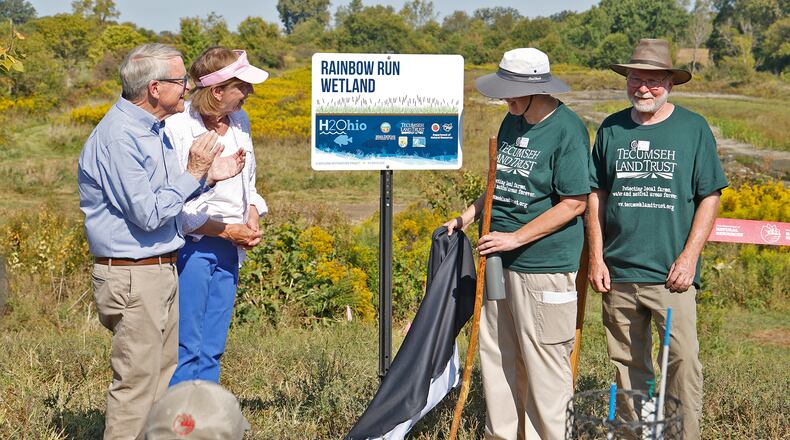“Today as we dedicate this, we’ve done now 183 wetlands that we have either completed since I became governor or that are in progress ... An additional 12 will take us to 195. We have to keep going and we intend to do that,” DeWine said. “Wetlands are a vital component to improve water quality across our state. Every new wetland we create or restore continues to build on all the progress we’ve been making over the years through H2Ohio.”
The new H2Ohio Rainbow Run wetland restored eight acres of private land, owned and donated by Tom and Susan Miller, that was previously an unfarmed pasture. This new wetland gets its name from the nearby Rainbow Run tributary, which flows into the Little Miami River, according to state officials. It will improve water quality and address flooding and erosion issues with a newly established channel of ponds and pools to filter sediment and nutrients before flowing into the Rainbow Run.
Wetlands improve water quality by trapping, filtering and removing excess nutrients, like phosphorus, from the water before flowing into other waterways. DeWine said wetlands are a “win-win-win” because they can help future generations, are a natural filter and support wildlife.
“Wetlands are something that we can do that will be here for our kids, our grandkids, our great-grandkids, and on and on (for generations), with not very much maintenance, so it’s a real investment,” DeWine said.
Credit: Bill Lackey
Credit: Bill Lackey
Donnie Knight, U.S. Fish & Wildlife Service, said “a cool thing about these projects is there’s so many stacked benefits.”
Knight said clearing and developing land “comes at some cost” of losing top soil that enters watersheds during high-water events, which causes floodplains to fill with post-settlement alluvium and reduces the amount of floodplain storage. He said by removing some of that material, a lot of times it can be repurposed, create more flood storage, has wildlife and fish community benefits, and flood protection.
“Then you also get the settlement nutrient uptake, you have a space for that high water event to filter out and settle, and instead of just floating down the stream and not being up taken, this gives it a chance to be the wetland, the sponge, the kidney of the landscape,” he said. “(And) by reducing the amount of water ripping down a water course, we’re holding that water on the landscape so ... you’re going to have less bank erosion, less culverts getting blown out, so it’s a direct benefit to infrastructure and protecting land.”
Credit: Bill Lackey
Credit: Bill Lackey
Tecumseh Land Trust, which partnered with the Millers, submitted the project for funding, which was awarded because of its cost effectiveness and anticipated benefits to water quality.
“Tecumseh Land Trust was thrilled to have a project selected in the first statewide round,” said Tecumseh Land Trust Executive Director Michele Burns. “We are proud to be a part of water quality improvements in the Little Miami River watershed and beyond.”
“We realized the land played an important role in the natural world,” Susan Miller said. “We began restoring that scrap of land and talking to anyone who would listen to us, and that’s how we ended up meeting a whole lot of terrific people, which led us to this wetland restoration project.”
The 11 other new wetlands projects will be located in nine counties including Athens, Butler, Delaware, Franklin, Greene, Holmes, Lake, Richland and Summit. The projects range from wetland restoration to enriching stream corridor forested areas.
H2Ohio, which launched in 2019, is a statewide water quality initiative designed to address complex issues impacting Ohio’s waters. It uses a comprehensive approach to reduce algal blooms, stop pollution, and improve access to clean drinking water by supporting best farming practices, road salt runoff reduction, litter cleanup, dam removal, land conservation and water infrastructure revitalization. For more information, visit h2.ohio.gov.
“One of the great things we have in Ohio that gives us a strategic advantage in regard to other states, something we’re very proud of, is our water. Keeping our water pure, this is one of the ways we can do it,” DeWine said.
About the Author



